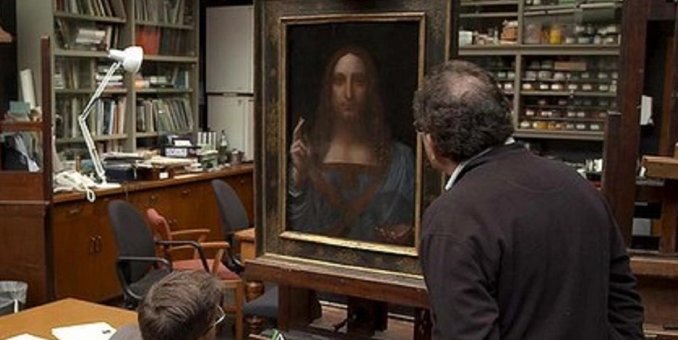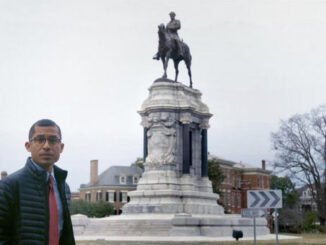When is a painting by the great Leonardo Da Vinci not a painting by Leonardo da Vinci?
That is the question being asked in director Andreas Koefoed’s latest documentary The Lost Leonardo. At least at first. What starts as a somewhat nerdish look at the controversy surrounding the discovery and restoration of a painting that could conceivably have been rendered by Leonardo da Vinci himself takes a sudden, surprising and engaging left turn into a world of hidden wealth and where politics can play a bigger part in art history than truth can.
Alexander Parish and Robert Simon are two art dealers who are always on the search for “sleeper paintings” – “a painting that’s being offered [for sale] which is clearly by a much better artist than the auction house has recognized.” And then, in the catalog for an upcoming sale at a small New Orleans auction house, there appeared a painting of Christ titled Salvatore Mundi, which Parish had a gut feeling it could be an unrecognized work of the great Leonardo da Vinci, the first new da Vinci to be discovered in 100 years.
The pair bough the painting for the tidy small sum of $1,175 and brought it to noted historian and restoration Dianne Modestini to examine and clean it up. Confident that what she was working with was indeed an authentic da Vinci, she proceeds to repair much of the damage that had accumulated on the painting over the years. This is where the first of the many controversies around the painting begins, as some art experts feel that the amount of restoration work done to it makes Salvatore Mundi more of a Modestini painting than a da Vinci painting. It’s a categorization that Modestini clearly rejects.
But it is here where the story starts to get diverge from the unexpected. As Parish and Simon search for a buyer for the painting, Russian oligarch Dmitry Rybolovlev decides that he would like to own it. Not to display, but to sit in a duty free vault at a airport known as a freeport as a way to keep assets away from the prying eyes of governments. Rybolovlev instructs his agent Swiss dealer Yves Bouvier – whose family just so happens to also be invested in these freeports – to acquire the painting. Bouvier does, at the cost of $83 million, before turning around and selling it to an oblivious Rybolovlev for $127.5 million. Over time, Bouvier helps Rybolovlev acquire 37 paintings, though he sells them all at a markup that earns him approximately $1 billion for himself. After Rybolovlev finds out and threatens Bouvier if he doesn’t pay back the money he feels he was defrauded out of, the oligrach decides to sell all of the pieces that Bouvier acquired.
With the other art works acquired at an inflated cost and possibly not selling for a profit at auction, Christie’s Auction House goes all in on promoting the upcoming sale of the Salvator Mundi as a once-in-the-lifetime sale, hoping that hyping the uniqueness of the sale would help drive the price. Ultimately, the painting would sell many times more than most experts estimated it would, netting $450 million from an anonymous bidder when the hammer fell.
Was the buyer Saudi Prince Mohammed bin Salman, as reliable rumors suggest? The Saudi government certainly isn’t saying as visual depictions of any prophet is considered highly sacrilegious in the Muslim faith, so one of the most powerful men in the country certainly could not admit to owning one. The Louvre certainly seemed to know who bought the painting when it went to build an exhibit celebrating 500 years of DaVinci in 2017. Curators stated that the painting would indeed be part of the exhibition only for opening day crowds to find a wall empty of anything except three picture hangers where the Salvatore Mundi was expected to be.
Did an examination of the painting by the museum reveal its origins to be inconsistent with what every had previously assumed. Did the owner want a prominent place of placement for the Salvatore Mundi? Where has the painting been since it was sold at Christie’s? Just more questions that add to the mystery surrounding the painting.
Koefoed structures his film in a rather straightforward, journalistic manner. As the painting moves through its story we are introduced to a succession of new interviewees who tell of their time in its orbit before moving on, occasionally backtracking to get reactions from people as to how the story progressed after they have left it.
Ultimately, Koefoed suggests the question as to whether or not the Salvator Mundi is a true DaVinci or not is somewhat moot. The truth is that someone did pay nearly half-a-billion dollars for it, only to lock it away from the world’s view. This is certainly not the act of someone who doubted, either rightly or wrongly, the painting’s province. And that just leaves the audience to come to their own conclusion as to the painting’s authenticity, or even if that matters at all.






